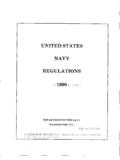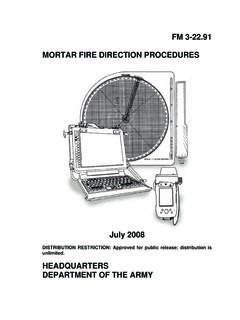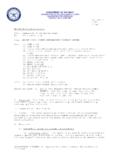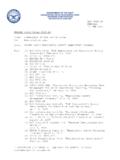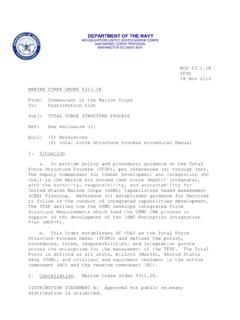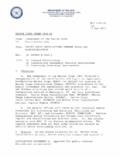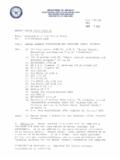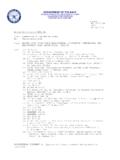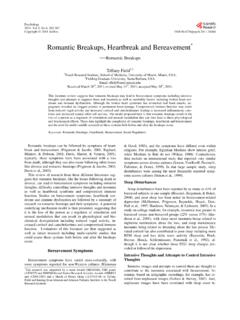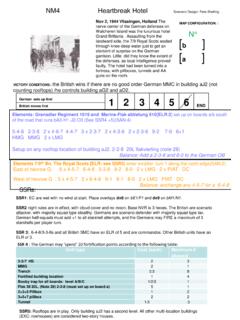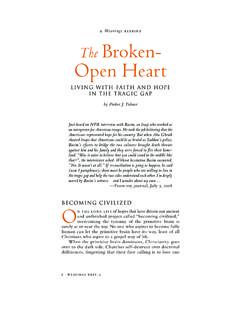Transcription of conspicuously absent. The key - marines.mil
1 5th marines from the Kansas Linefor additional offensive operationseast of the Punchbowl. Except forthe 8th ROK Division on Thomas'right flank, the rest of X Corpswould seize another hill mass sooncalled " heartbreak Ridge."Byersexpected the marines to resumethe attack on 11 only 48 hours to mount anattack, Thomas had little alterna-tive but to look again to the 7thMarines to lead the advance onKanmuhong Ridge, the hill massdirectly north of Yoke Ridge andthe division's next objective. Theconcept of theoperationenvi-sioned a two-phase operation thatwould begin with the 7th Marinesseizingthe two most dominantpeaks at the eastern edge of theridge, Hills 673 and 749. To elimi-nate a transverse ridge spur (Hill680),a secondary attack wouldstrike directly north from the HaysLine on Yoke Ridge.
2 This missionwent to 3d Battalion, 7th marines ,commanded by Lieutenant ColonelBernard , with the mainattack to 1st Battalion, 7th marines ,under Lieutenant Colonel James , relatively untouched by thefight for Yoke Ridge. When the 7thMarines had secured the Hill 673-Hill749area,the1stMarineswould come forward and continuethe attack up Kanmubong's longaxis, "ridge-running," to capture aseries of peaks designated (east towest) Hills812,980,1052, and1030. The scheme of maneuverwould allow tanks to fire acrossthe front of the advancing troopsand artillery fire (even naval gun-fire) to converge in concentrationsfrom the firing positions to thesouth and southeast. The advanceshad to be supported by hundredsof "chiggy bearers"sincetherewere no roads of any kind to bringthe ammunition, food, and waterforward in any other and strongly-built bunkersand trench systems,the NorthKoreans made the 7th marines (allthreebattalions) pay dearlyinthree days of fighting, 34 dead and321 wounded.
3 The assault compa-nies that crossed the line of depar-tureinthe morning fog of 11 September did not expect a walk-over. Despite the hour of intenseartillerypreparation,the NorthKorean defendersfought withunflagging bunker system came ringedwith mines and booby-traps, andKorean mortar shells and grenadesshoweredcripplingfragmentsacross every contested heavy machine gunfire from higher up KanmubongRidge tookitstoll among theMarine assault units that struggledforward with flamethrowers andsatchel again dark memories ofIwo Jima and Okinawa came to theJapanese military tradition than theSoviet, the North Koreans showedno hesitation in launching counter-attackslarge and small and atunexpected times and from theenemy did not overrun any Marinepositions, only quick shooting andquick thinking broke the backs oftheattacks withbulletsandartilleryshells.
4 Although the 3dBattalion took its objective with noassistance, Colonel Nickerson hadto commit his 2d Battalion to aidthe 1st Battalion on 12 a converging two-battalionattack the companiesincol-umn finally seized Hill 673, andthe subsequent 2d Battalion attackon Hill 749 fought itself out farshort of the crest. In all the fightingtank fire proved decisive when thebunkers could be identified andfired upon,line-of-sight. Manybunkers,however,could havebeen reached by close air support,457conspicuously absent. The keyground maneuver came from acompany of the 1st Battalion thatmade an undetected night marchto reach a poorly-defended entrantto Hill 673, then assaulting throughabreachinthe North ,the2dBattalion'sattackonHill749stalled with the three rifle compa-nies reduced, scattered, and bat-tling back small counterattacks inthe dark before a battalion of the1st marines replaced them on 13 September.
5 So hard-pressed andscattered were the marines of 2dBattalion, 7th marines , that the bat-talion misreported its location andgave Nickerson the impression thathis regiment had taken Hill 749,which it had not. Moreover, theapproaches to the hill were stillheld by some very combativeNorth Koreans. Assuming opera-tional control of the 2d Battalion,the1stMarines, under ColonelThomas A. Wornham, picked uptheresponsibilityfor occupyingHill 749. Only a helicopter recon-naissance proved thatHill749would have to be taken logistical burden of sup-portingfivecommitted infantrybattalions(thesituation on 13 September) proved too much forthe "chiggy bearers" of the KoreanService Corps 103d Division, butthe marines now had an alternativeforthe emergency resupply ofammunition and medical goodsand the evacuation of the serious-ly-wounded:the Marine Corpshelicopter.
6 Although the light heli-coptersof Marine ObservationSquadron 6 (VMO-6) had been afixture in operations since August1950, the battle for KanmubongRidge opened a new era in MarineCorps history, the combat employ-ment of helicopters as an integralpart of Marine air-ground Krulak had both playedkeyrolesindevelopingtheCOn-ceptofv erticalenvelopmentandfightingforfundstop rocureandtesthelicoptersinHMX-l,theexper imentalhelicoptersquadroncreatedatMarine CorpsAirStation,Quantico, (HMR-161),commandedbya heli-copterpioneer, , 'ssquadronof300 Marinesand15 SikorskyHRS-1transporthelicoptersarrived attheairstrip(X-83) , , ,1stMarines, ,facedanotherday'sbattlewithplentyofammu nition,water, , , ]92""':.11k)'ersdale,Penns :\a\)'in19' ,heenteredBucknelllni\erit)'.fromwhichhe grad-uatedin19' 'attendingBucknell,heenrolledinthei\lari neCorpsHesel'\'ePlatoonLeader'sprograman d\vascommissionedinthe"larineCorpsReel'\ ,;andhistoryinLewisburg,Penn"ylvania,hef orebeingcalledtoacti\' ,7th"larines,inKorea,hisbraveryincoverin gthewith-(\rawalofhisplatoononKanmubongR idgeon12S'ptember19'5 Jwasrecognizedbytheposthumousawardofth>I edalofIlonol'.
7 Lliscitationreads,inpan:SecondLieuten:.l lllRamerfearlessl. ledhismenupthesteepslopesand,althoughhea ndthemajori-tofhisunitwcr'woundedduringt heasccnr, ),carriedtheallacktothetop,person:.llly: .Innihilatedoneenemyhunker\yithgrenadean dc:.lrhinefireandcapturedtheobjeClive\\ :.lgainst:. \'el'\yhelminghostilecoulllerallack,heor deredhisgrouptowithdr;1\\andsingle-hande dlyfoughttheenemytofurnishcoverforhismen andfortheevacuationofthreefatallywounded i\brines.,everdywoundedasecondtime,, ' :lrlllll'lllofI)CIcIl'CPhOlO(LS\IClAIH02 ';In1963,a f:.lcilityforphysicalconditioningat~lari neorpsBaseQuantico,Virginia, :. "'i\1,R(Ret)Whirlybirdsen Marine Transport Helicopter Squadron(HMR) 161 deployed to Korea, the squadrontook with it an aircraft that pushed the techni-cal state-of-the-art in helicopter design into a new fron-tier.
8 Designated the HRS-1, the Sikorsky-designed andbuilt helicopter had enduredthe inevitable ups anddowns that characterized the introduction of any government contracts,theSikorskyAircraftDivisionof theVought-SikorskyCorporation, Stratford, Connecticut, produced an aircraftdesignated the S-55, first flown in 1949. Initially market-ing the aircraft as a commercial utility helicopter, IgorSikorsky hoped the S-55 could compete with the PiaseckiH-21 (or PD-22), which had been adopted by the AirForce for its air rescue service. The Navy, however, wasin the hunt for a general-purpose helicopter that could beadopted for shipboard use. Naval aviators liked the S-55because of its economical design, modest size, and the HO4S-1 in its naval model, the S-55represented at least two major engineering advances: theaddition of a tail rotor for greater stability in flight and afront-mounted Pratt & Whitney R-1340-57 engine thatcould generate a respectable 600 horsepower.
9 The engineplacement helped solve a nagging problem of weight-dis-tribution and flight characteristics. Prior helicopter mod-els placed the engine directly under the rotor-blades, adesign that gravely limited any so-designed helicopter tovery light loads and insured flight instability. The front-mounted engine dramatically increased the helicopter'scarrying capacity and simplified maintenance since theHRS-1 hadl clam-shaped nose doors that provided easyaccess to the engine for the ground crew mechanics. Thenew design also improved vertical flight the earliest stage of evaluation, 1948-1949, Navy andMarine Corps officers, encouraged by Sikorsky, saw capa-bilities the helicopter did not yet have, even under opti-mum weather and altitudeconditions. The originalrequirement the naval aviators placed on the helicopterwas a 10-man load (225 pounds per Marine) to be carried150 miles.
10 The requirements shrank, as it became moreand more obvious that the HRS-1 was not going to be atwo-ton-plus lifter. All the helicopter's other characteris-tics, however, made itthe aircraft of choice for theBureau of Aeronautics, and the Marine Corps joined theprogram in August 1950, with an initial order of 40 HRS-ls that went to Korea came into service witha gross weight rating (7,000 pounds at sea level) about1,000 pounds slighter than originally designed with apayload reduced to 1,420 pounds under optimal flightconditions. Its troop load dropped from 10 to four to helicopter's maximum speed remained at 90 knots,but its range had dropped by half to 70-mile round , the HRS-1 was not a "whirlybird" of dlisap-pointment, but Archives Photo (USN) 80-G-433347none of the cargo drifted off toplaces and users unknown.

